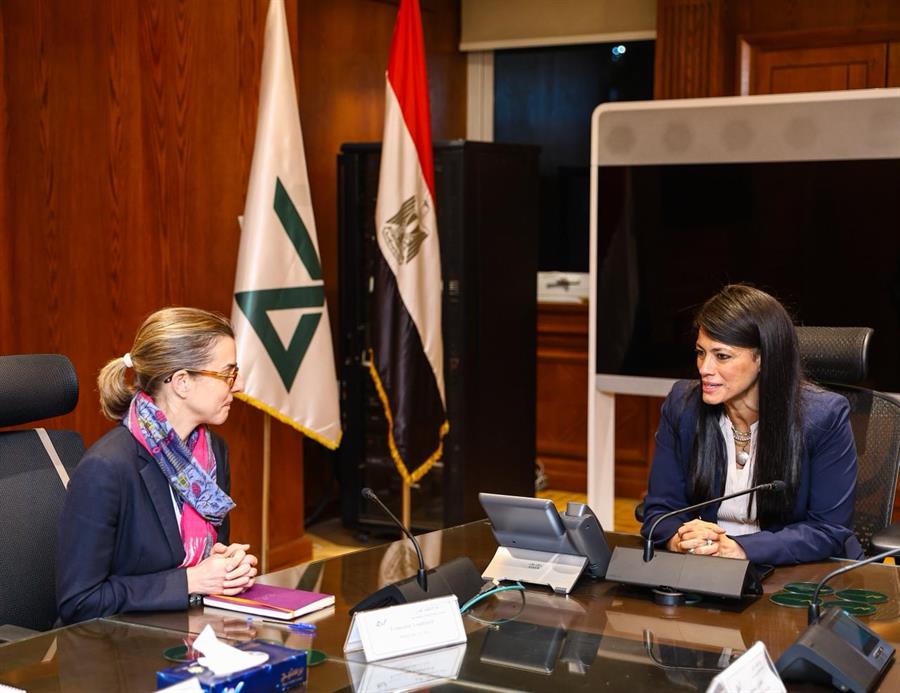Minister of Planning, Economic Development, and International Cooperation Participates in the Annual Scientific Conference of the Information and Decision Support Center

13 May 2025
Dr. Rania Al-Mashat reviews efforts to implement the National Program for Structural Reforms and enhance macroeconomic stability.
H.E. Dr. Rania Al-Mashat, Minister of Planning, Economic
Development, and International Cooperation, participated in the annual
scientific conference of the Information and Decision Support Center (IDSC) in
collaboration with the Faculty of Economics and Political Science, entitled
"Structural and Institutional Reforms in Egypt: The Road to Sustainable
Growth.", in the presence of Dr. Osama El-Gohary, Assistant to the Prime
Minister and Information and Decision Support Center Chairman , Dr. Mohamed
Sami Abdel Sadek, President of Cairo University, Dr. Hanan Mohamed Ali, Acting
Dean for Faculty of Economics and Political Science at Cairo University, and
Dr. Omneia Helmy, Professor of Economics, Faculty of Economics and Political
Science at Cairo University, Chairman of the conference.
During her speech, H.E.Dr. Rania Al-Mashat stated that over
the past years, the Egyptian state has come a long way in the process of
economic reform, with the aim of achieving macroeconomic stability, addressing
structural imbalances, and enhancing the economy's resilience in the face of
challenges. These efforts have come through a mix of macroeconomic policy
reforms, supported by a set of integrated structural and institutional reforms,
implemented by various state agencies, overseen by the Ministry of Planning,
Economic Development, and International Cooperation.
H.E. explained that this process, which is deepening year
after year, is increasingly appreciated by the international community and
global economic institutions, as major institutions such as the International
Monetary Fund and the World Bank recently raised their forecasts for the growth
of the Egyptian economy in 2025 and 2026, while they have downgraded their
growth forecasts for many countries worldwide, due to increasing complexities
in the international economic landscape. This confirms the effectiveness of the
reform policies adopted by the Egyptian state and the confidence of
international partners in its path.
Al-Mashat added that the Egyptian state seeks to achieve a
transformation in the Egyptian economic model in order to reach sustainable
growth, based on tradable and exportable sectors through stimulating
investment, localizing industry, and implementing integrated measures that
would enhance the resilience of the national economy and its ability to absorb
shocks. The Egyptian state has implemented a number of economic and structural
reform measures since March 2024, which was reflected in the increase in the
GDP growth rate during the second quarter of fiscal year 2024/2025 to 4.3%,
compared to 2.3% in the same period of the previous fiscal year.
H.E. clarified that despite positive indicators, the most
important aspect is the components of this growth and which sectors experienced
greater growth. The second quarter growth was driven by the non-petroleum
manufacturing sector, which recorded a growth rate of 17.74% for the third
consecutive quarter, compared to a contraction of 11.56% in the same period of
the previous fiscal year, Additionally, growth was seen in the transport andin
addition to growth in the transportation and storage, tourism, communications
and information technology sectors, which reflects the impact of structural
reforms aimed at enhancing productivity and supporting export-led growth.
Furthermore, H.E. noted that structural and institutional
reforms to support the path of inclusive and sustainable growth are one of the
main pillars of the work of the Ministry of Planning, Economic Development, and
International Cooperation, as part of its efforts to implement the National
Program for Structural Reforms, in coordination with all relevant ministries
and in partnership with international financial institutions and development
partners. Within the framework of three main pillars: enhancing macroeconomic
stability, improving the business environment and promoting the competitiveness
of the Egyptian economy, and supporting the transition to a green economy.
There is no doubt that structural reforms are a top priority in the
government's program until 2027, given the pivotal role these reforms play in
consolidating macroeconomic stability and enhancing its ability to face
external challenges
In this context, H.E. also added that the Egyptian state
succeeded last year in implementing over 86 structural measures, including
enacting amendments to the Public Finance Law to set an annual ceiling on
government debt, preparing a draft procedural guide for program and performance
budgeting, taking measures to cancel exemptions granted to state-owned
enterprises, as well as investment incentives, and facilitating tax policies.
H.E. highlighted that the Ministry of Planning, Economic
Development, and International Cooperation is working to enhance coordination
with partners, primarily the European Union and the World Bank, to mobilize
funds to support the state's general budget to implement the national program
of structural reforms. Egypt received approximately €1 billion from the
European Union by the end of 2024, and the ministry is intensifying its efforts
in coordination with development partners to complete the second phase of the
macroeconomic support mechanism and budget support worth €4 billion, under
which a large number of structural reform measures will be implemented to
enhance fiscal policy control, stimulate the investment environment, and
establish macroeconomic stability.
Al-Mashat continued that within the framework of moving
forward with the reform process and achieving the transition to the new
developmental model of the Egyptian economy, the ministry is working on
preparing the National Narrative for
Economic Development, an executive plan to achieve economic development, in order to achieve alignment between the
government program and Egypt Vision 2030, and set clear targets that reflect
the ambitions of the government program and are consistent with current changes
in the global economy.









